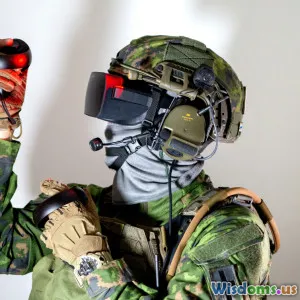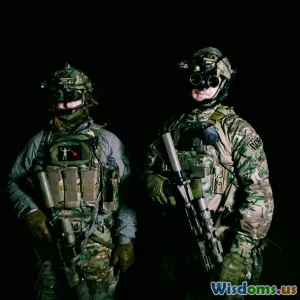
Secrets of Soldier Augmented Reality on Modern Battlefields
8 min read Discover how augmented reality transforms soldier capabilities on battlefields with real-time data, enhanced situational awareness, and tactical advantages. (0 Reviews)
Secrets of Soldier Augmented Reality on Modern Battlefields
Augmented Reality (AR) — not just a buzzword in gaming and consumer tech — is quietly revolutionizing modern warfare. Imagine a soldier wearing a smart visor that overlays mission-critical data directly onto the terrain in front of them. Enemies highlighted, friendly unit positions mapped, navigation aids, medical status updates, and threat assessments all projected onto a battlefield view in real-time. This is not science fiction. It’s the cutting edge of soldier augmentation that is transforming battles from chaotic guesswork into coordinated precision.
In this article, we uncover the secrets behind soldier AR innovations on modern battlefields — how they work, what makes them powerful, and the tactical advantages reshaping infantry combat.
Unlocking Real-Time Battlefield Awareness
At the heart of soldier augmented reality systems is the ability to present vital real-time information directly to troops without distracting them from their environment. Traditional communication methods—radio reports or handheld devices—interrupt the soldier’s focus. AR aims to fuse digital information seamlessly with physical surroundings.
Heads-Up Displays (HUDs) and Smart Goggles
Advanced helmets equipped with transparent visors or goggles bring augmented reality to the frontline. For example, the U.S. Army Integrated Visual Augmentation System (IVAS), built on Microsoft’s HoloLens technology, offers soldiers a HUD displaying:
- Enemy location alerts generated from drone feeds and battlefield sensors
- Navigation waypoints marked on terrain
- Friendly troop positions to avoid friendly fire
- Weapon aiming reticles overlayed on real-world view
By processing data from multiple sensors and AI algorithms into an intuitive visual format, these HUDs drastically cut reaction times and eliminate information overload.
Real-World Implementation Example: IVAS
Declared as one of the most ambitious soldier AR projects yet, IVAS integrates thermal imaging, night vision, target tracking, and voice commands. In extensive field tests, soldiers reported improved situational awareness and target identification accuracy by up to 30%, enhancing mission effectiveness while coping with the often confusing battlefield chaos.
Enhanced Communication and Coordination
Another secret benefit of AR on modern battlefields is streamlined communication. AR gear can visually project commands or tactical information directly into a soldier’s field of view, which significantly reduces verbal communication delays and quickens collective response.
Digital Mapping and Position Sharing
AR systems employ GPS and mesh networks to continuously update unit locations on digital maps accessible in the visor. This allows soldiers to:
- Visualize squad movements in real-time
- Share target data instantly
- Coordinate flanking or retreat maneuvers with minimal radio chatter
For instance, during joint Colt exercises in Europe, NATO forces used AR to coordinate multinational unit operations, improving cross-unit collaboration and reducing mission completion time.
Visual Signals Over Voice Commands
Communications can be more covert and clear through gestures encoded in AR. Commands such as “hold position” or “advance left” can be transmitted silently, preventing interception by enemy surveillance or avoiding noise during stealth operations.
Tactical Training and Mission Preparation
Beyond immediate battlefield use, AR also transforms how soldiers train and prepare.
Immersive Simulations
AR-powered training environments superimpose virtual enemies, obstacles, and mission objectives into live ranges or training grounds. This hybrid setup offers:
- Greater realism compared to pure virtual simulations
- Safe but unpredictable training scenarios
- Instant feedback and performance analytics
NATO’s Centre of Excellence for Military Medicine uses AR to simulate realistic battlefield injuries, helping medics train under stressful conditions with high fidelity.
Mission Rehearsal
Soldiers can use AR maps embedded with intelligence about enemy positioning, terrain layout, and potential hazards, enabling immersive walk-throughs before actual deployment. This practice improves operational readiness and confidence significantly.
Challenges and Ethical Considerations
While AR technologies offer incredible benefits, several challenges limit widespread adoption, and ethical concerns demand attention.
Power and Network Dependency
Soldier AR systems rely heavily on battery life and network connectivity for data sharing. In remote or electronic warfare scenarios, disrupted networks can render AR useless or misleading.
Information Overload and Cognitive Burden
Improperly designed interfaces risk overwhelming soldiers with excessive data—counterproductive in high-stress combat. Balancing detailed information with usability is a continuous design challenge.
Ethical Implications
There are concerns about privacy, data security, and potential psychological effects of constantly augmented environments on soldiers. Militaries must establish guidelines to protect soldiers’ mental health and safeguard sensitive battlefield intelligence.
Future Frontiers: AI and AR Integration
The blending of Artificial Intelligence (AI) with AR promises to unlock new warrior capabilities.
Predictive Analytics and Decision Support
Imagine an AR system that not only displays where enemies currently are but simulates possible enemy moves and suggests optimal tactical options. AI can analyze battlefield conditions, past missions, and sensor inputs to offer live recommendations.
Autonomous Drone Coordination
Soldiers could command reconnaissance drones via AR commands, receiving live video streams integrated directly into their visors. This real-time aerial intelligence strengthens battlefield control and early threat detection.
General Mark Milley, chairman of the U.S. Joint Chiefs of Staff, has emphasized the transformational impact of AI and AR, stating: "Those who dominate the integration of advanced tech will dictate the future battlefield environment."
Conclusion
Soldier augmented reality represents a quantum leap in infantry warfare evolution. By transforming the way information is delivered, processed, and acted upon, it empowers soldiers with unprecedented situational awareness, communication, and tactical decision-making tools. While challenges persist, ongoing innovations in government-run programs and collaborations with tech companies point toward AR becoming a standard warfighting capability.
Understanding the secrets behind augmented reality’s deployment helps us appreciate how the modern battlefield is becoming smarter, safer, and more coordinated — reshaping combat as we know it.
As military technology continues to advance rapidly, staying informed about soldier AR innovations is crucial not only for defense analysts but also for technology enthusiasts and policymakers. The future of warfare isn’t just about firepower but about information dominance powered by augmented reality.
References:
- U.S. Army IVAS Program Overview – Microsoft HoloLens Partnership
- NATO Joint Exercise Reports, 2023
- Interview with General Mark Milley, Defense News, 2024
- Centre of Excellence for Military Medicine – AR Training Initiatives
- Military AI and Visual Computing Conference Proceedings, 2023
Rate the Post
User Reviews
Popular Posts
















